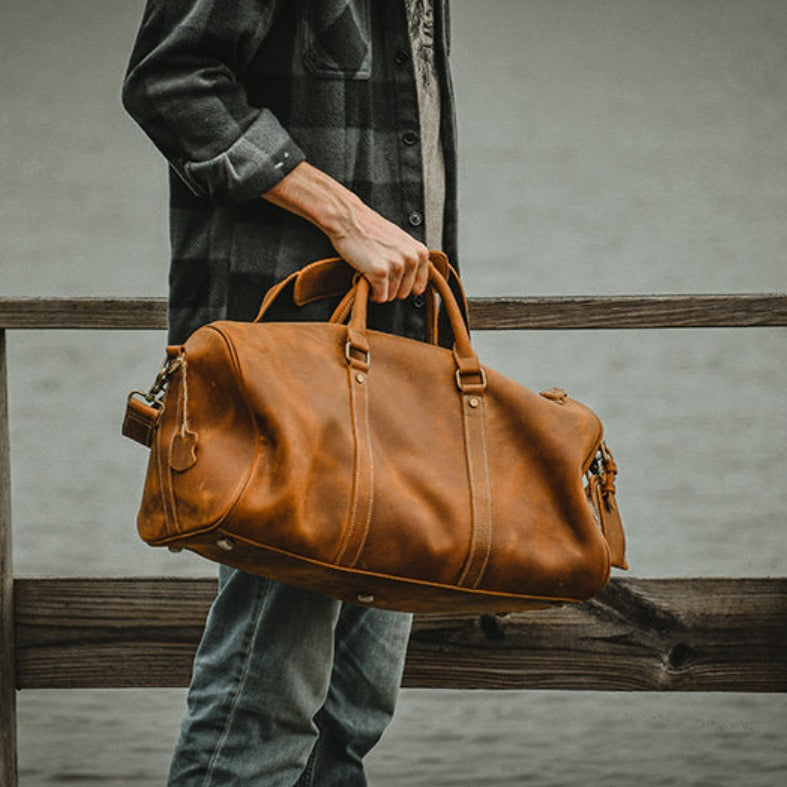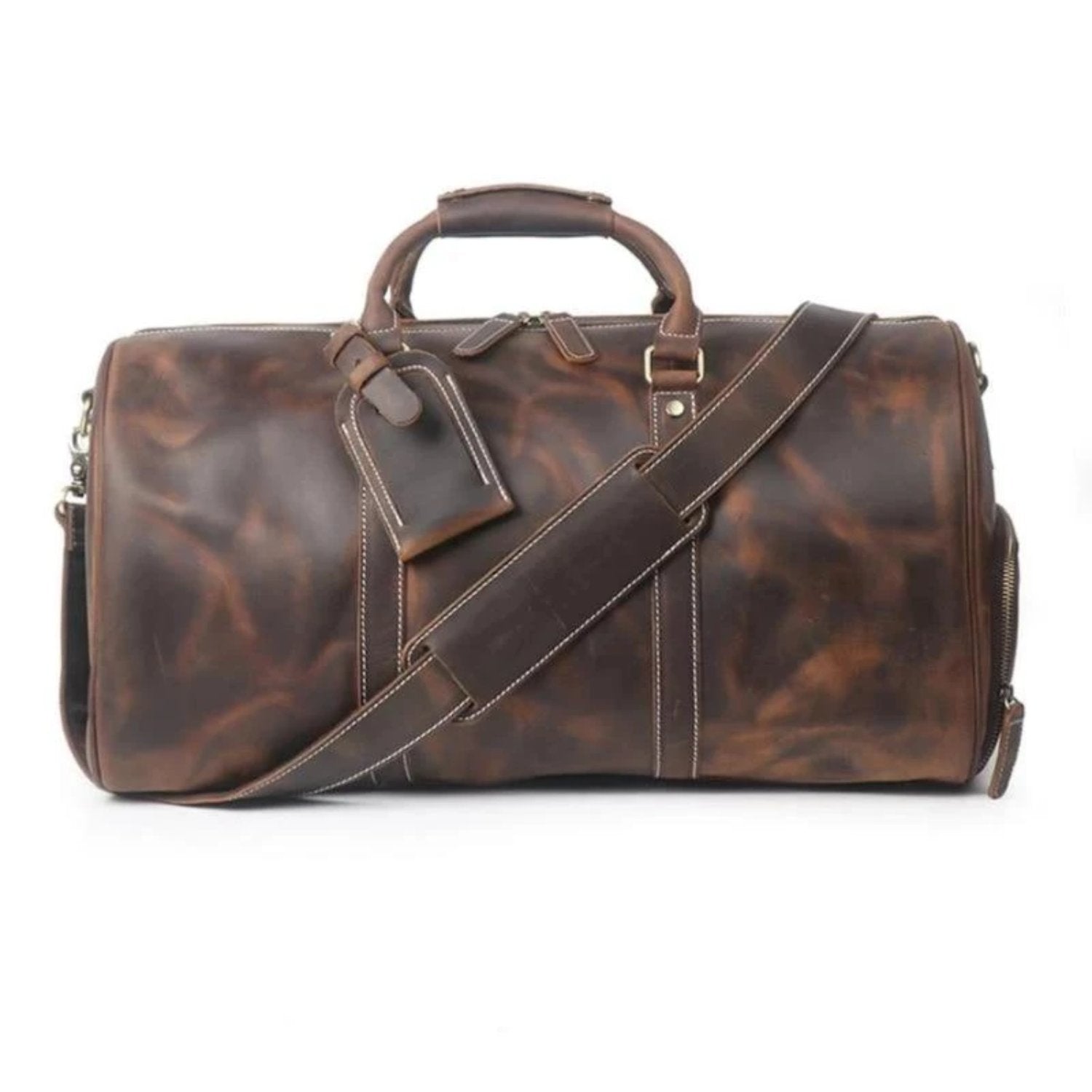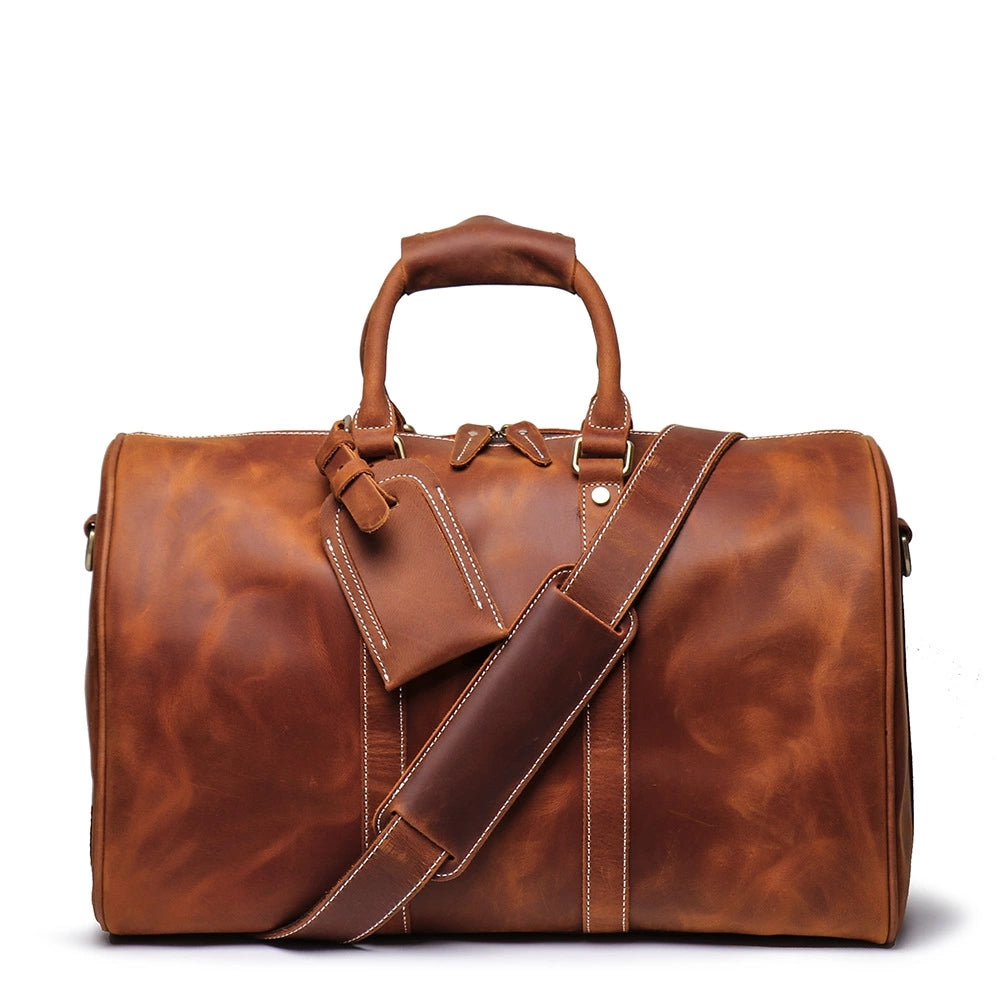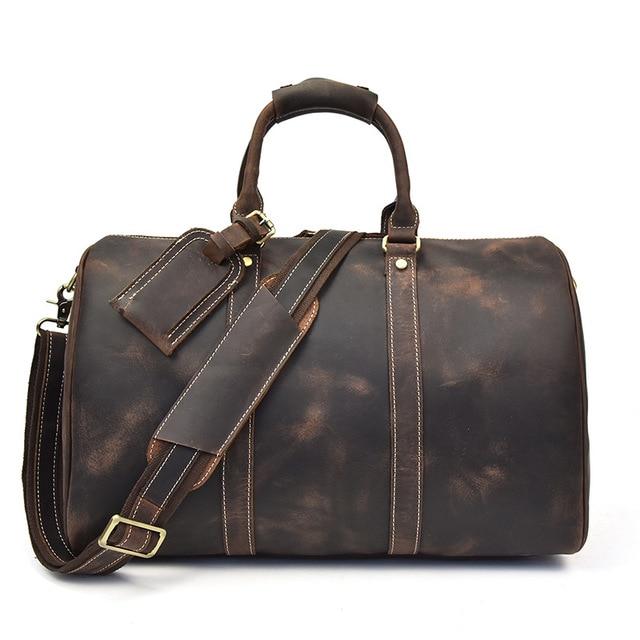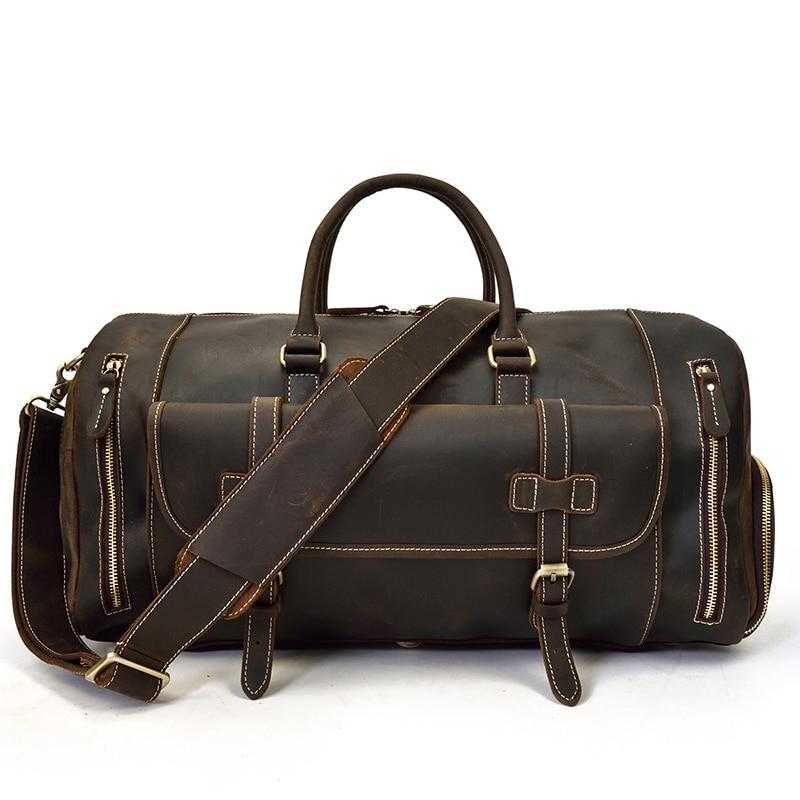Full grain vs top grain leather. Does the distinction even matter? As matter of fact, it does. While both full-grain and top grain leather are among the highest quality of leather, they still have their differences. We will therefore identify which is full-grain leather and which is top grain. Likewise, we will look at how their characteristics and how they are similar and different from one another.
Many people wonder what the difference is between full-grain leather and top grain leather. The difference lies in the finish of the leather. Top grain leather is one of the most versatile and durable leathers available, so it is widely used in commercial and retail leather goods. This type of leather is generally in the upper part of the hide (the thinner side), and is split to expose the surface of the grain. Full-grain leather is from the top layer, but also has a layer of grain that isn't split leather. It is because of this that the full-grain leather is the most durable and highest quality leather you can find.
Key Takeaways
- Full-grain leather represents the highest quality available, maintaining the hide's natural characteristics and offering superior durability
- Top-grain leather provides a more refined, uniform appearance through processing, making it ideal for commercial applications
- The manufacturing process significantly impacts the leather's characteristics, with splitting affecting durability but improving workability
- Price differences between the two types reflect both quality and manufacturing complexity
- Both types are superior to genuine leather and other lower-grade options, making either choice a worthwhile investment
Identifying Different Leather Types
Before we pit full-grain leather vs top grain leather it is important to know which is which. For the untrained eye, the leather may look the same. However, not all leather is of the same kind and quality. Likewise, if you are looking for only the best quality of leather it is important to know which leather is which: full-grain vs top grain leather.
The Impact of an Animal's Life on Leather Quality
The life of an animal significantly influences the quality of the leather produced from its hide. Factors such as the animal's age, diet, and overall health contribute directly to the characteristics of the leather. Research has confirmed that stress-free environments tend to yield higher-quality hides with minimal blemishes, which directly contributes to the superior characteristics of full-grain leather (Guţă et al., 2016; Tomljenović et al., 2021). For instance, animals raised in stress-free environments often yield hides with fewer scars and blemishes, resulting in higher quality full-grain leather. On the other hand, animals that have experienced rough handling or harsh living conditions typically produce lower-quality hides, which may contain marks, scars, or other imperfections that affect the leather's aesthetic appeal.
Additionally, the diet of the animal plays a role; a healthier diet leads to a more robust skin, enhancing the leather's durability and ability to develop a rich patina over time. Understanding these aspects highlights the importance of responsible and ethical animal husbandry practices in producing premium leather goods, ensuring not only the quality of the final product but also promoting the well-being of the animals involved.
Understanding Top Grain Leather
Topgrain leather is the second-highest quality of leather among all leather types.This excludes faux leather since faux leather is technically not leather. Furthermore, among all leather types top grain leather is probably the most commonly used. This is because among all other types top grain leather offers a pristine look.
Origin and Processing
Technically, top grain leather comes from real animal skin such as horse's skin or more commonly from cow's skin. But to be specific, all that skin is not all top grain leather. Top grain leather got its name for a very literal reason.
Literally, the very top layer of the animal skin is either sanded, buffed, or shaved off. Many will commonly refer to this process as "splitting the leather" or just "splitting". Likewise, this process removes the top layer of the leather, taking with it the scars and marks on the animal skin. Therefore giving it a much more pristine look. A more refined look in comparison to full-grain leather as others would say. However, this process also removes the most durable outer layer of the leather. This will affect the leather's longevity by shaving more of the leather hide thickness, however, you will still have good quality leather.
The Splitting Process
If you're like us, then you love to find great deals on high-quality leather products. But sometimes it's hard to know what's a good deal and what's a bad deal. Take top grain leather for example. Many people think that top grain leather is the best kind of leather around, but it's actually just one of six different leather types and second-best in quality. So, if you're looking to buy a new leather bag, backpack, satchel, or messenger bag this year, it's best to know what leather your bag is really made of.
Now you may be wondering "if splitting leather will reduce the leather's longevity, then what is the point?" Believe it or not, there many reasons why leather is split. One reason is that sometimes the animal skin is too thick and likewise difficult to handle. They will, therefore, split the leather laterally into thinner more workable layers. Another reason is to start with a fresh top surface, free from marks and scars. A fresh top also gives the leather artisan the opportunity to apply a variety of finishes to the leather that can enhance the natural grain pattern.
Understanding Full Grain Leather
Full-grain leather is the best among all leather types. Moreover, only the highest quality of animal skin can be made into full-grain leather. This may also be the reason why full-grain leather is expensive and that is because of its quality.
Just like top grain leather, full-grain leather comes from animal skins. Full-grain leather however will not go through the sanding, burning, shaving process. Therefore it is safe to conclude that full-grain leather is made of the entire thickness of the grain. Studies on leather quality have demonstrated that retaining the complete grain structure and natural imperfections significantly impacts both the material's longevity and its ability to age beautifully over time (Guţă et al., 2016; Tomljenović et al., 2021). Likewise, the scars, grains, pores, and other textures are left intact.
Comparing Full-Grain and Top Grain Leather
| Feature | ⭐ Full-Grain | 🥈 Top-Grain |
|---|---|---|
| Layer Used | Entire top layer (no sanding) | Top layer sanded + finish coat |
| Appearance | Natural marks, scars, unique | Perfectly smooth & uniform |
| Patina | Develops rich, beautiful patina | No real patina (coated surface) |
| Durability | Strongest — lasts decades | Very durable but less than full-grain |
| Breathability | Excellent (natural pores) | Reduced (coated) |
| Price | Highest (rarer hides, harder to work) | 20–40% cheaper |
| Best For | Heirloom bags, belts, boots | Jackets, sofas, uniform look items |
| 🎯 Quick Decision Guide | |
|---|---|
| Want lifetime piece + patina → Full-Grain | Want flawless look + lower cost → Top-Grain |
| Daily carry bag/wallet → Full-Grain | Furniture or jacket → Top-Grain often better |
While both full-grain and top grain leather are both high-quality leather they do have their differences. While many believe that top grain leather is inferior to full-grain leather it is important to keep an open mind. This is because different types of leather have their own advantages and disadvantages in comparison to others. Sometimes it can just be a matter of perspective and preference. They are both real leather.
Quality Comparison
When it comes to types of leather and quality grades, top-grain leather only comes in second to full-grain leather in terms of durability and quality. Among the various grades of leather, these grain leathers are considered high-quality leather products. This is because full-grain leather retains the entire grain layer and natural characteristics of the original animal hide. That fact, therefore, is significant in determining the overall durability, strength, and longevity of the leather material.
The natural grain and surface imperfections in high-quality hides contribute to their distinct appeal and beautiful patina over time. Unlike genuine leather or split leather, which are lower quality grades, grain leather products maintain their natural appearance and develop a rich patina through long-term use. The leather production process, whether using vegetable tanning or chrome tanning, preserves the outer layer of these premium materials, resulting in a superior durability that makes them an ideal choice for leather furniture and other applications.
Cost Differences
The higher the quality, the higher the cost in terms of durability and aesthetic appeal. Being the best of all leather grades and types of leather, full-grain leather costs more than top-grain leather. There are many factors that affect the price difference between these grades of leather. An easy example is the manufacturing cost in the leather industry. Since full-grain leather is unrefined and maintains its natural characteristics and natural grain, it is thicker in comparison to top-grain leather and more difficult to work with during the production process. Full grain is an excellent choice for leather bags and develops a beautiful patina over time, but not so great for things like a leather jacket or leather sofa even though it is the highest quality of leather. Likewise, it is much easier for manufacturers to work with top-grain leather since it is thinner and more workable, offering a more uniform appearance.
Another example would be how easy it is to procure the raw materials and high-quality hides. Not all animal skins or animal hides can be turned into full-grain leather. Only the highest quality of animal hide, free from natural imperfections and surface blemishes, can be turned into this high-quality leather. The entire grain layer, including the outermost layer with its natural texture, remains intact through the tanning process. On the other hand, if the original animal hide is unfit to be full grain, manufacturers may split the leather and remove the topmost layer for top-grain leather during the leather splitting process. This creates a smoother surface while still maintaining superior durability. Both genuine leather and split leather come from the lower layers, representing the lowest grades of leather quality.
For long-term use and the authentic leather experience, grain leather products are the preferred choice, developing a rich patina and maintaining their natural characteristics with proper care using high-quality leather conditioners and regular cleaning with a damp cloth.
Appearance Differences
Here we see a significant difference between the two. This also makes distinguishing the two easier compared to other leather types. Full-grain is unique. It has visible imperfections such as scars and marks on its surface due to the animal's experience while it was still alive. On the other hand, the top-grain has no imperfection visible. This is because these imperfections are sanded down, removing its natural grain. You could say that top grain leather has a uniform look in contrast to full-grain leather. Both options are better than genuine leather, corrected leather, corrected grain leather, aniline leather, or bonded leather.
Aging Characteristics
Another significant difference between the two is the patina. Only full-grain leather will develop a patina as it ages. Patina only develops on the natural grain or topmost layer of the animal skin. By sanding down the natural grain the leather will be less breathable and prevent the patina from developing on its surface over time.
Durability Comparison
Full-grain leather will always be stronger and more durable than top grain leather. This is because by sanding down the top layer, you also sand off the strong fibers in the hide. It is the best solution for a quality leather product.
Real-World Application: The Dagny Weekender Case Study

During our development of the Dagny Weekender travel bag, we experienced firsthand the crucial differences between full-grain and top-grain leather. After extensive material testing, we chose to craft our weekender exclusively from full-grain leather, understanding that travelers need exceptional durability and character in their accessories.
The decision to use full-grain leather for the Dagny Weekender was driven by several factors we observed during development:
1. Durability for Travel: The natural strength of full-grain leather's intact fibers proves essential for a bag designed to withstand frequent travel and varying conditions.
2. Character Development: As travelers use their Dagny Weekender, the full-grain leather develops a unique patina, telling the story of each journey and adding personality to the bag.
3. Comfort Considerations: The natural characteristics of full-grain leather allowed us to create ultra-soft handles and straps that provide superior grip and comfort, even when the bag is fully loaded.
4. Organization Without Compromise: While designing multiple interior pockets for laptops and accessories, we found that full-grain leather's structural integrity better maintains the bag's shape and functionality over time.
Full Grain Leather Care and Maintenance Tips
Taking care of full grain leather is essential for preserving its beauty and durability over time. One of the first steps in maintaining full grain leather is regular cleaning; using a soft, damp cloth to wipe away dirt and dust helps maintain its natural luster. Additionally, it's important to condition the leather with a high-quality leather conditioner every six months to keep it supple and prevent it from drying out or cracking. When storing full grain leather items, avoid exposing them to direct sunlight or extreme temperatures, as these elements can cause fading and damage. Opt for breathable fabric bags for storage instead of plastic, which can trap moisture and lead to mold growth.
Finally, heeding specific spills or marks is critical; blots should be attended to promptly with a clean, dry cloth, and it’s advisable to test any cleaning products on a discreet area before application. Following these simple care routines will ensure your full grain leather retains its refined character and enhances its unique patina over the years.
Why Trust Our Leather Expertise?

At Steel Horse Leather, our deep understanding of leather quality and craftsmanship comes from years of hands-on experience in leather bag manufacturing. Our master artisans have dedicated their lives to perfecting traditional leatherworking techniques, giving us unique insights into the subtle differences between leather grades and their practical applications. This expertise isn't just theoretical – it's built on daily work with various leather types and countless hours of careful material selection and crafting.
Our commitment to leather quality extends beyond mere craftsmanship. We've developed extensive relationships with leather suppliers worldwide and have implemented rigorous quality control processes to ensure we work with only the finest materials. Our thorough vetting process of leather suppliers and tanneries has given us comprehensive knowledge of leather processing, from raw hide to finished product. This hands-on experience with the entire leather supply chain allows us to speak authoritatively about the characteristics, benefits, and practical applications of different leather grades.
When we discuss the differences between full-grain and top-grain leather, we're drawing from real-world experience in selecting and working with these materials for our own products. Our insights come from observing how different leather types perform under various conditions, how they age over time, and how they respond to different manufacturing techniques. This practical knowledge, combined with our commitment to transparency and education, ensures that the information we share is both accurate and valuable for anyone looking to make informed decisions about leather products.
Frequently Asked Questions
How Can I Tell If My Leather Product Is Full-Grain Or Top-Grain?
When comparing types of leather and grades of leather, full-grain leather will show natural imperfections, surface imperfections, and natural texture, while top-grain leather has a more uniform appearance and smooth surface due to the leather splitting process. The natural characteristics and original grain remain intact in full-grain leather, which develops a beautiful patina over time through long-term use, unlike top-grain leather. The quality of leather can be determined by examining the natural variations and grain layer of these real leather options.
Is The Price Difference Between Full-Grain And Top-Grain Worth It?
The value depends on your specific needs when choosing between different leather grades. While full-grain leather is a more expensive grade and offers unmatched durability, top-grain leather provides a consistent finish and refined appearance, making it a practical choice for certain applications like leather upholstery and leather garments. Consider the balance between quality and your intended use when making informed choices about leather products.
Why Do Manufacturers Choose Top-Grain Over Full-Grain?
In the leather industry, manufacturers often prefer top-grain leather because it's more flexible leather that's easier to work with during the production process, offering consistent quality and a uniform surface. The tanning process, whether through vegetable tanning or chrome tanning, creates a superior material that's more cost-effective while still maintaining high-quality standards. This makes it an ideal choice for a wide range of applications.
Will My Leather Product Last Longer If It's Full-Grain?
Generally, yes. Full-grain leather retains its natural fibers and strongest fibers, providing exceptional durability. However, proper care and maintenance, including regular cleaning with a damp cloth or soft cloth (avoiding harsh chemicals), are essential factors in the longevity of any leather item. Professional leather cleaner services and high-quality leather conditioner can help maintain the leather's quality over time.
Can Top-Grain Leather Be As Good As Full-Grain For Certain Uses?
Yes, top-grain leather can be superior for specific applications where a consistent appearance and smooth texture are more important than maximum durability. This makes it an excellent choice for leather jackets or grain leather furniture. The finishing coat provides water resistance and a sleek appearance, making it a popular choice for various leather products where aesthetic appeal is paramount.
Final Verdict
In a match between full-grain vs top grain, the former will emerge as the winner. However, the other is still a good option. While technically full-grain is better, your preference and capacity to purchase also matters. One important thing to note is that they are both better than Genuine Leather. The important thing to remember is that either way they are both great investments to purchase and own leather good.
References
Guţă, S., Albu, L., & Bostaca, G. (2016). Applications of life cycle assessment to leather industry - an overview and a case study. Proceedings of The 6th International Conference on Advanced Materials and Systems. https://doi.org/10.24264/icams-2016.iv.4
Tomljenović, A., Živičnjak, J., Barišić, A., & Akalović, J. (2021). Influence of sampling location on physical and mechanical properties of full grain leather. Koža & Obuća, 69(2), 4-11. https://doi.org/10.34187/ko.69.2.1



























